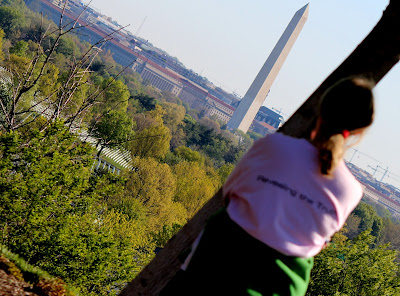On May 19, my Aunt Laura and I visited Arlington National Cemetery in Arlington, Virginia. We toured much of the cemetery, but our purpose for visiting was to attend the 150th Anniversary Celebration of Taps, the quintessential military song to our fallen soldiers.
Photos from this trip will be posted in three parts in an attempt to keep this short and ‘user-friendly.’ This part will have general Arlington National Cemetery photos; part II will detail the Taps ceremony, and part III will pay tribute to the Tomb of the Unknown Soldier. I hope I can do justice through my photos, to Arlington.
Arlington National Cemetery performs 27 to 30 funeral services each day, and the day we visited was no exception. The rolling green hills are dotted with trees that are hundreds of years in age and complement the gardens found throughout the 624 acres of the cemetery. This impressive landscape serves as a tribute to the service and sacrifice of every individual laid to rest within the hallowed grounds of Arlington National Cemetery.
Arlington House, aka The Custis-Lee Mansion
This mansion is prominently located on a hillside overlooking much of the cemetery. The 19th-century mansion seems out of place amid the more than 250,000 military grave sites that stretch out around it. Yet, when construction began in 1802, the estate was not intended to be a national cemetery.
The mansion was originally constructed as a living memorial to George Washington by his adopted grandson, George Washington Parke Custis.
When Custis died, he willed the property to his daughter, Mary. She eventually married a young Army officer, Robert E. Lee, and Arlington became their home until the outbreak of the Civil War.
At the onset of the Civil War Lee volunteered to serve in the Confederate Army. During the war, the estate was seized by the Union Army, which made it a headquarters.
Arlington National Cemetery was established by Brig. Gen. Montgomery C. Meigs, who commanded the garrison at Arlington House, and appropriated the grounds on June 15, 1864, for use as a military cemetery.
Meigs did not take on this task due to a sense of duty to country or the Union Army, his goal was to render the estate uninhabitable should the Lees' attempt to return after the war. Meigs, a southern native who fought for the Union, never forgave Lee for fighting for the Confederacy. He created the nation’s premiere cemetery purely out of hatred for Robert E. Lee!
The following three pictures were from the most perfect rose garden I've ever seen! The roses are maintained in pristine condition and you would be hard-pressed to find a flaw!
 |
| This is from the Civil War section. |
These photos are just a snapshot of this wonderful and somber place....























































